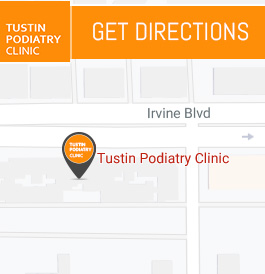Heel Spur vs Plantar Fasciitis: What’s the Difference?
Heel spurs and plantar fasciitis are common foot conditions causing significant pain. Heel spurs are bony growths on the heel bone, often causing localized pain. Plantar fasciitis involves inflammation of the plantar fascia, leading to stabbing heel pain, especially in the morning. Dr. Charles Baik, DPM, at Tustin Podiatry Clinic, offers advanced treatments to effectively alleviate the discomfort. For more information, contact us or book an appointment online. We are conveniently located at 17400 Irvine Blvd Suite H Tustin, CA 92780.


Table of Contents:
What are the common symptoms of a heel spur vs plantar fasciitis?
How are heel spurs diagnosed compared to plantar fasciitis?
Can lifestyle changes prevent heel spurs or plantar fasciitis?
How do you prevent heel spurs or plantar fasciitis from recurring?
At Tustin Podiatry Clinic, we specialize in diagnosing and treating a range of foot conditions, including heel spurs and plantar fasciitis. While both conditions are characterized by heel pain, they are distinct in nature and require different treatment approaches.
A heel spur, a bony growth that protrudes from the heel bone, can cause sharp, stabbing pain, especially upon waking up or after long periods of rest. This pain may subside after walking but can return after prolonged standing or sitting. Other symptoms may include tenderness, stiffness, inflammation, swelling, and in some cases, a visible bump on the heel. At Tustin Podiatry Clinic, our expert podiatrists can diagnose heel spurs through a physical examination and imaging tests, providing personalized treatment plans to alleviate your discomfort.
Plantar fasciitis involves inflammation of the plantar fascia, a band of tissue running across the bottom of the foot. This condition often results in pain near the inside of the heel and the foot’s arch, typically worsening with the first steps after awakening or prolonged standing. Additional symptoms may include stiffness, tenderness, redness, difficulty walking, and numbness or tingling in the toes. Our team is experienced in diagnosing and treating plantar fasciitis, often recommending exercises, orthotics, and lifestyle changes to reduce pain and inflammation.
Although heel spurs and plantar fasciitis share similarities, they are characterized by different pain patterns. The pain from heel spurs is typically localized, while pain from plantar fasciitis tends to radiate along the arch of the foot.
Both these conditions can trigger significant discomfort and pain, particularly in the heel area, and require different diagnostic approaches.
Heel spurs are bony growths forming on the underside of the heel bone, typically due to repeated strain or pressure. Our podiatrists start the diagnosis process with a comprehensive medical history evaluation and physical examination. After assessing the symptoms and examining the foot, we may recommend imaging tests like X-rays to confirm the presence of a heel spur.
Plantar fasciitis, an inflammation of the plantar fascia (a thick band of tissue running across the foot bottom), is another condition we diagnose and manage at our clinic. Our podiatrists can often diagnose plantar fasciitis based on a physical exam and a detailed discussion of the patient’s symptoms and medical history, without the need for imaging tests.
However, if the symptoms are severe or unresponsive to conservative treatments, our podiatrists may order imaging tests to rule out other potential causes of heel pain, such as a stress fracture or pinched nerve. These tests can show inflammation of the plantar fascia and help differentiate between heel spurs and plantar fasciitis.
These common conditions can be caused by a variety of factors, including obesity, prolonged standing or walking, high-impact activities, and poorly fitting shoes. However, we believe in the power of lifestyle modifications in preventing or managing these conditions.
• Footwear Selection: Choosing the right footwear is vital in preventing foot-related complications. Our podiatrists can help you understand the importance of well-fitted shoes and guide you in selecting footwear with adequate cushioning, arch support, and a wide toe box.
• Activity Modification: Our clinic emphasizes the importance of regular exercise, especially strength-building activities for the feet and legs. We can also guide you on how to avoid overuse, which can lead to heel spurs and plantar fasciitis.
• Orthotics: Our podiatrists can help you understand the benefits of orthotics and guide you in choosing custom-made or over-the-counter options for additional support and cushioning.
While there is no definitive cure for heel spurs or plantar fasciitis, making these lifestyle changes can significantly reduce your risk. If these changes do not provide adequate relief, we recommend seeking medical attention.
At Tustin Podiatry Clinic, we place a special emphasis on the prevention of common foot conditions like heel spurs and plantar fasciitis. We understand that these conditions can cause significant pain and discomfort, which is why we offer a comprehensive prevention plan designed to reduce the likelihood of recurrence.
• Stretching and Strengthening Exercises: We believe in the power of exercise in preventing foot conditions. We can provide you with a tailored exercise plan that includes regular stretching of the Achilles tendon, plantar fascia, and calf muscles. We also recommend strengthening exercises like calf raises and toe curls. We advise against high-impact activities, suggesting low-impact activities like swimming and cycling instead.
• Avoid Overuse: Our podiatrists can guide you on limiting activities that may aggravate heel pain, such as prolonged standing or walking. We also recommend using ice on your feet after strenuous activities to help reduce inflammation.
• Night Splints: We can provide night splints to help stretch the plantar fascia while you sleep, maintaining flexibility and reducing inflammation.
• Follow-up Care: We recommend regular checkups at our clinic to adjust your treatment plan as needed. Even after the pain has subsided, we advise continuing preventive measures to reduce the risk of recurrence.
At Tustin Podiatry Clinic, we believe that maintaining a healthy weight, regular low-impact exercise, wearing supportive shoes, daily foot and leg stretches, and proper aftercare can all contribute to preventing heel spurs and plantar fasciitis from recurring. Our team is dedicated to helping you care for your feet, every step of the way. For more information, contact us or book an appointment online. We are conveniently located at 17400 Irvine Blvd Suite H Tustin, CA 92780. We serve patients from Tustin CA, Irvine CA, Garden Grove CA, Orange CA, Anaheim CA, Costa Mesa CA, and Lake Forest CA.

Additional Services You May Need
▸ Heel Pain Treatment
▸ Laser Fungal Nail Treatment
▸ Ingrown Toenail Treatment
▸ Ankle Sprain Treatment
▸ Foot and Ankle Medicine & Surgery
▸ Orthotics Custom
▸ EPAT/Shockwave Therapy
▸ Hammertoe
▸ Arthritis Treatment
▸ Diabetic Foot Care
▸ Flat Feet Treatment
▸ Foot Warts Treatment
▸ ClarixFlo





